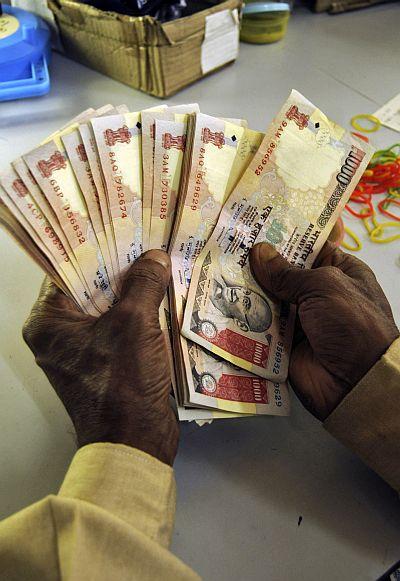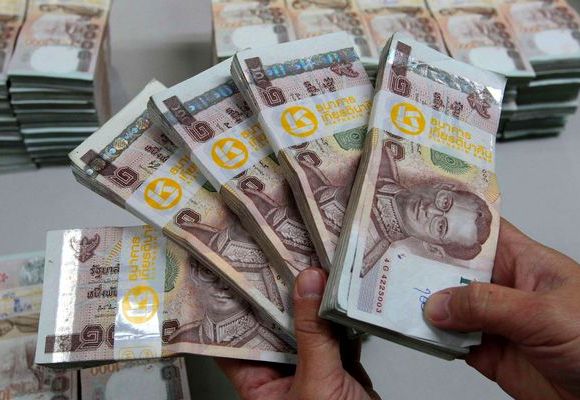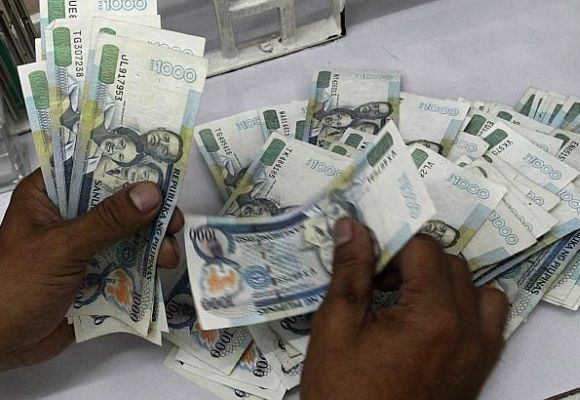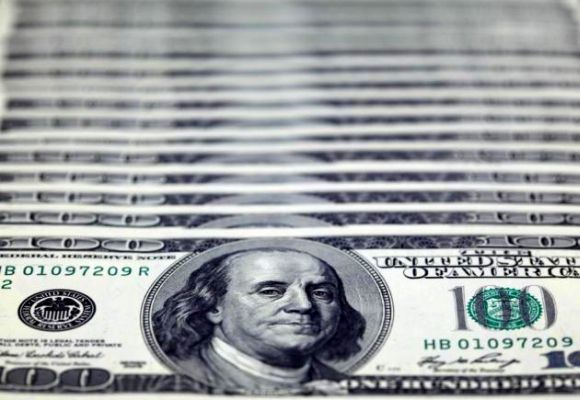Photographs: Jayanta Dey/Reuters Jongwoo Cheon in Singapore
The Indian rupee was set to end its worst quarter in at least a decade on Friday, leading slides among emerging Asian currencies in April-June on worries about the withdrawal of US stimulus and China's cash crunch.
Though most regional units made modest advances on Friday, emerging market assets are expected to remain under pressure in the third quarter as concerns about the Federal Reserve's stimulus plans and China's slowing economy persist.
The rupee lost 9.1 per cent against the dollar in the second quarter, the largest percentage fall since such data on Thomson Reuters became available in 2003.
The Indian currency suffered from more outflows than other emerging Asian currencies in the recent global markets rout due to worries about a record-high current account deficit.
…
Rupee to see worst quarter in 10 years
Image: A bank employee counts Thai baht notes in Bangkok.Photographs: Sukree Sukplang/Reuters
The Thai baht lost 5.8 per cent in the quarter and the Philippine peso declined 5.6 per cent. If those currencies maintain the losses through to Friday's close, their percentage falls would be the largest since the second quarter of 2008, Thomson Reuters data showed.
The South Korean won fell 2.7 per cent, while the Singapore dollar declined 1.9 per cent, which would be the largest since the third quarter of 2011. The Malaysian ringgit lost 2.5 per cent.
"Markets are leaning closer towards being cautious on Asia debt and currencies, with positions being lightened up further," said Suresh Kumar Ramanathan, head of regional interest rate and FX strategy at CIMB Investment Bank in Kuala Lumpur.
"That means a number of fund management and asset management firms are resigning to the fact of lower returns for the year."
…
Rupee to see worst quarter in 10 years
Image: US Federal Reserve Chairman Ben Bernanke.Photographs: Kevin Lamarque/Reuters
Fed Chairman Ben Bernanke said on June 19 that the central bank may moderate the pace of quantitative easing later this year and end the stimulus by mid-2014.
That boosted expectations of a reduction in global liquidity and prompted outflows from emerging Asian countries, once a major beneficiary of easy money pumped by major central banks.
The speculation also lifted US Treasury yields, reducing yield differentials between US and emerging Asian countries.
Adding to pressure on regional currencies, a brief but sharp spike in China's money market rates fuelled fears that the world's second-largest economy could slow further.
But emerging Asian currencies are seen having priced such worries in to some degree, traders and analysis said.
…
Rupee to see worst quarter in 10 years
Image: Photos of yuan (top) and US dollar banknotes are displayed at a money exchange in Hong Kong.Photographs: Bobby Yip/Reuters
Some regional units such as the won may find relief as investors may seek stronger fundamentals, they added.
"As we saw with the first round of unwinding, investors will select assets on fundamentals rather than dumping Asia as a whole," said Jeong My-young, Samsung Futures research head in Seoul.
"Asian currencies are not free from the Fed and China concerns in the third quarter. But there will be demand for healthy countries, like Korea and Taiwan," Jeong said.
Frances Cheung, Credit Agricole CIB's senior strategist in Hong Kong, picked up the won and the Taiwan dollar as her favourite emerging Asian currencies.
The South Korean currency is expected to get support from capital inflows, especially foreign bond buying, while the Taiwan central bank is intent on maintaining a stable currency, Cheung added.
…
Rupee to see worst quarter in 10 years
Image: North Korean leader Kim Il-sung is seen on this 5,000 North Korea won banknote.Photographs: Carlos Barria/Reuters
Won
The won gained on Friday extended foreign buying powered Seoul shares .KS11. Exporters' demand for month-end settlements prompted stop-loss dollar selling, traders said.
The benchmark KOSPI ended up 1.6 per cent as regional stocks gained on improved sentiment after two US Federal Reserve officials sought to reassure markets that any tightening of its stimulus drive was still a distant prospect.
"The mood has changed since yesterday (Thursday). We could see 1,130 next week if foreigners continue to buy stocks," said a senior foreign bank trader in Seoul, referring to the won's value.
But some traders hesitated to chase the won. Importers and some offshore funds bought dollars on dips.
"The won may rise more in a short term, reporting firmer highs. But there are still possibilities to weaken as investors stay worried about policy risks from the U.S. and China," said a South Korean bank trader.
…
Rupee to see worst quarter in 10 years
Image: A worker counts one thousand pesos bills inside a money changer in Manila.Photographs: Romeo Ranoco/Reuters
Taiwan Dollar
The Taiwan dollar gained as foreign investors continued to but local shares.
Taiwanese exporters also purchased the island's currency for month-end settlements.
Currency players largely ignored the central bank's decision late on Thursday to leave interest rate unchanged as it was widely expected.
Philippine Peso
The peso rose as stock inflows lifted Manila shares and on strong local bonds.
The Philippine main stock index rose 1.1 per cent, while yields of five-year bonds and 10-year bonds slid.
…
Rupee to see worst quarter in 10 years
Image: US dollar notes are seen in this picture illustration.Photographs: Nicky Loh/Reuters
Investors covered dollar-short positions before the weekend, but some traders expect the peso to extend gains next week on hopes for more foreign stock buying and remittances inflows.
"With this kind of move in the equity market, the guys who sold last week must be knocking their heads on the wall," said a foreign bank trader in Manila.
"We should continue to see inflows. The key is if US 10-year yields stabilise. But as long as the yields trade from 2.30 and 2.60, it will be OK," said the trader, adding he expect the peso to strengthen to 42.80 per dollar.
The 10-year US note yields fell to 2.4591 percent on Friday in Asia.
(Additional reporting by Roger Tung in Taipei and Lee Kuoung-ho in Seoul)









article